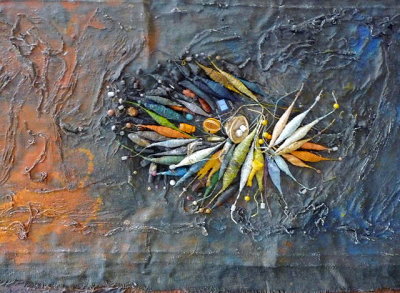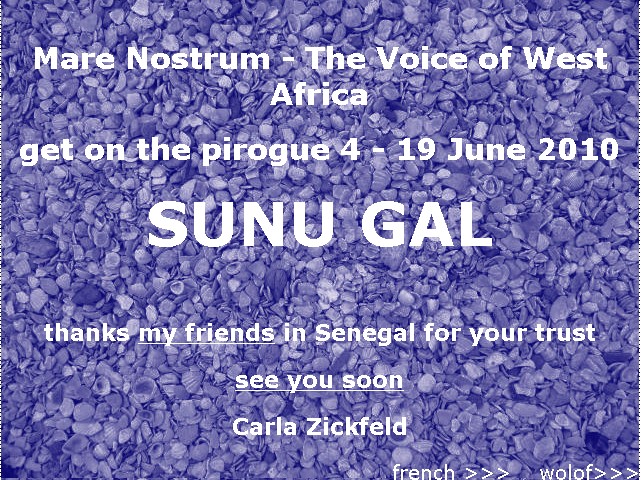M A R E N O S T R U M - S p a c e f o r D i a l o g u e a n d D i v e r s i t y
Collective Memory and Collective Consciousness
THE VOICE OF WEST AFRICA - in Relationship with the surrounding Sea
Sense and Senses - Learning in the float of life
Project proposal by Carla Zickfeld - (project closed)
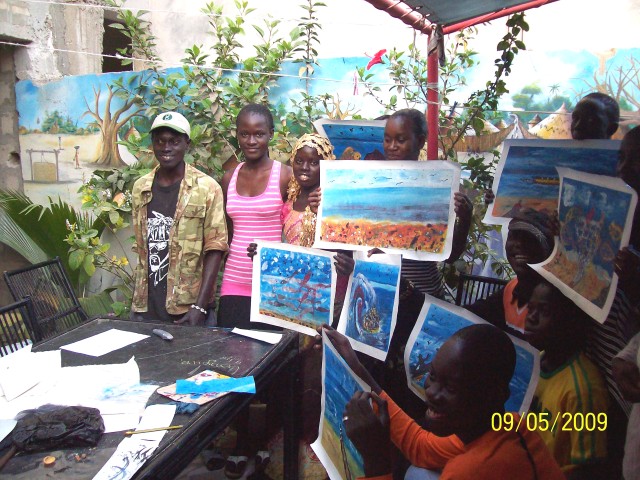
The Mare Nostrum project concept was launched in 2009. Click here for the flyer for Mare Nostrum Senegal.
The photo on this page is courtesy Aliou Sall in the arts village, Dakar.
THE APPROACH - The Way
-
The Project "Mare Nostrum - Space for dialogue and diversity" intents to go towards an aesthetic formation :
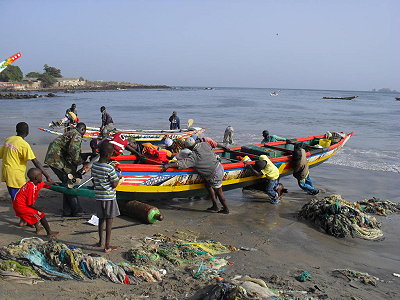
-
The Project should start with the school network in West Africa, experienced first in Senegal, with an exemplary methodology:
The main methodological objective is to prepare the young people that they become able to develop the Project in autonomy; it should become their project = their identification, in which they become capable in modelling and communicating - with the most diverse means - autonomously the singular voices of their environments.
How to go about this? The initiator, together with the Mundus maris coordinator for West Africa, will only provide through a methodological guideline the tools enabling the young people to express the essential roots of their living space in relationship to the sea - and finally to develop their own point of view.
The methodology is determined by the work in progress itself that will be set in motion – step by step - by motivating impulses, developed precisely with the growing experience in the region, beginning from the first immersion of the project initiator in Senegal onwards.
-
The Project embraces two cycles - and will be introduced by the initiator and the local coordinator - in an exemplary way - in the region itself :
First cycle: Collective Memory
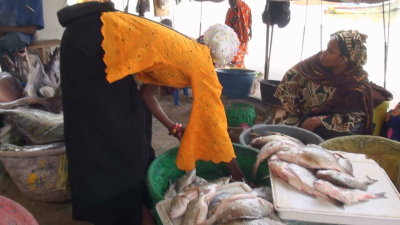 The collection of the memories, related to the surrounding sea
The collection of the memories, related to the surrounding sea
The identification
Second cycle: Collective Consciousness
Find an own visualized position in relation to the research results - mediated by the various scientific modules.
Each cycle should conclude with a manifestation in an appropriated place in West Africa.
The photos on this page are courtesy respectively, Nduwhite Ahononu Ndubuisi, taken May 2010 on the beach of Soumbedioune, near Dakar (above), Stefan Karkow, taken June 2010 in the fish vending area in Hann (below).
THE PREPARATION - The first Immersion in Senegal
The project preparation was led by Carla ZICKFELD in collaboration with Aliou SALL.
Both are founding members and vice presidents of Mundus maris.
Stefan KARKOW ensured photos and video coverage, unless indicated otherwise in the text.
-
Discovering the living space of the people involved:
 To be able to give impulses for learning in the float of life, the initiator of this project should first of all have the opportunity to immerse herself in the living space of the region where the initial approach will be developed in the interaction with the people who should be involved with the project: Students and teachers, artists, musicians, writers or story tellers, scientists, fishermen and women.
To be able to give impulses for learning in the float of life, the initiator of this project should first of all have the opportunity to immerse herself in the living space of the region where the initial approach will be developed in the interaction with the people who should be involved with the project: Students and teachers, artists, musicians, writers or story tellers, scientists, fishermen and women.
-
The first Immersion in Senegal: 4 - 19 June 2010
Click here to see the draft schedule of the visit.
A short background information on the fisheries and ecosystem situation in Senegal and wider West Africa is available here (general public brochure summarising the results of a major scientific conference).
First impressions upon arrival in Dakar
In the following, a few first spontaneous impressions, collected during the travel and the rich human encounters, are presented on these pages describing the preparatory phase of the project. These will be documented and elaborated in greater detail after the trip.
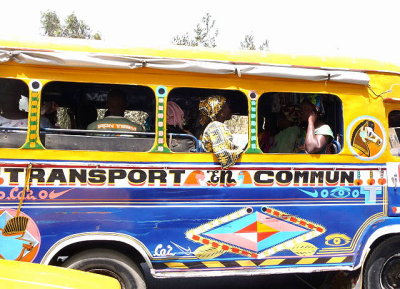 Upon arrival in Dakar, Carla ZICKFELD and Stefan KARKOW were offered a warm welcome by Aliou SALL. Dalal AK Diam.
Upon arrival in Dakar, Carla ZICKFELD and Stefan KARKOW were offered a warm welcome by Aliou SALL. Dalal AK Diam.
They were impressed by the very special atmosphere of Dakar in Senegal and the warmth of the reception. The first photos are coming through.
 They stopped at a group of griots from Guinea who were chanting and making music for their fellow guestworkers from this neighbouring country of Senegal.
They stopped at a group of griots from Guinea who were chanting and making music for their fellow guestworkers from this neighbouring country of Senegal.
See the action here live (video)
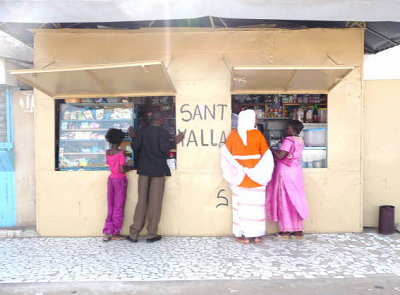
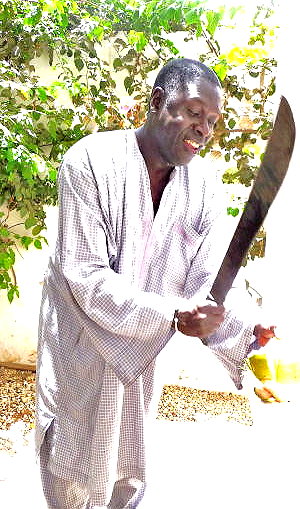 At lunch time, Aliou's family extended a warm welcome to Carla and Stefan.
At lunch time, Aliou's family extended a warm welcome to Carla and Stefan.
Together they enjoyed a richly flavoured traditional meal uniting everybody around a huge plate, Trébou Dieune.
The dish consists of rice and fish. After this, Aliou prepared the dessert - cutting the coconut with the machete. Hands are still on and the coco and mangoes were as delicious as the main dish.
After this first encounter with people and food, the visit of the Biennale of Dakar was on the programme, before its successful conclusion on 7 June 2010.
Turn the page to get some impressions.
Impressions from the Biennale DAK'ART 2010 - contemporary African Art
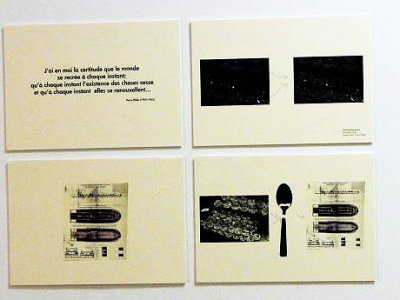 The principal venues for the DAK'ART 2010 official programme were the National Gallery (La Galérie Nationale) and the National Museum (Le Musée National).
The principal venues for the DAK'ART 2010 official programme were the National Gallery (La Galérie Nationale) and the National Museum (Le Musée National).
Carla reflects on her visit and says: "After the visit of the Biennale DAK'ART 2010, I have understood much better the explosiveness of contemporary African art which involves itself in an outstanding way with the existential questions today.
In the light of the overall framework of this manifestation, it seems we have reached a moment of collective consciousness about the fact that we need to understand culture - and arts as part of it - as one of the most important vectors of material and moral wellbeing and happiness of the individual. The following pictures should be viewed in this understanding as a synthetic and explemplary vision of this notion."
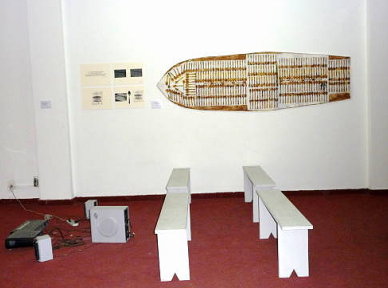 Here are some words taken from the introduction to the catalogue of the Biennale, by Gérard SENAC:
Here are some words taken from the introduction to the catalogue of the Biennale, by Gérard SENAC:
"For the second time, I am the President of the Biennale of African Art, in the year when it celebrates 20 years of its existence, in the country which itself celebrates the 50 years of its sovreignty. I consider this a great privilege and appreciate this fact in its full value...
"Under the aegis of its first President-Poet, Leopold Sedar Senghor, Senegal has early on given priority to Culture as one of the vectors of the material and moral well-being and happiness of the individual and has fortunately discarded a narrow vision of artistic expression as a priviledge for an elite, which had enriched itself in doubtful ways and was unproductive...
"In a world, which perceives Africa only through the deforming prism of misplaced pessimism, the resilience of the Biennale throughout these two decades ... is a strong signal emitted from our country, on a continent, where no other manifestation of this scale has been able to persist... "
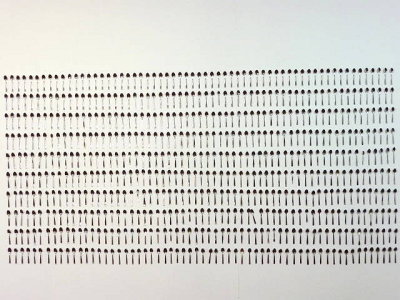 Here the 'mottoes' of the two Commissioners of the Biennale:
Here the 'mottoes' of the two Commissioners of the Biennale:
According to Rachida TRIKI:
"A desire for emancipation"
According to Kunle FILANI:
"Eliminate the obstacles to creativity and dry Obama's tears".
The images to the right show but very few examples of artistic approaches (all photos by Stefan Karkow).
Kiteng Banza MOURIDJA, born 1980 in the Democratic Republic of Congo presented her installation "Union of States - from 1848 to this Day", 2009. We show two partial views and the general overview to the right above.
Louis BASSENE, an up and coming Senegalese artist also selected to expose some of his works in Thailand shortly, showed 'Clandestine immigration' at DAK'ART 2010.
More information on a selection of participating artists is available at the website of the Biennale DAK'ART 2010. Click here to discover more.
The Arts Village, Dakar
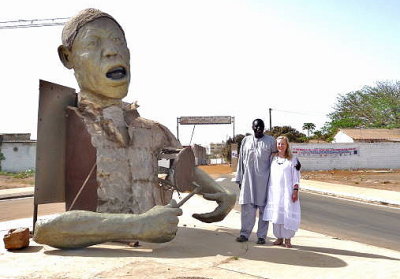
Like for every Biennale, the Arts Village participates in the 'Off Programme'. This year, 60 artists, 6 workshops, murals and more are addressing coastal erosion through the mirror of artistic reflection and expression.
The picture shows Aliou and Carla next to one of the monumental art works in the village.
In the context of her preparatory visit for the project 'Mare Nostrum - The voice of West Africa', Carla had several meetings with artists to explore opportunities for collaboration. Among others she met the three artists presented briefly on the following pages:
- Moussa Sambalaye DIOP
- Mamadou NDIAYE 'THIA'
- Tamsir Diogou SECK.
From an artistic perspective they share a common denominator, but their relationship with the sea differs.
The artists: Moussa Sambalaye DIOP
 We met Sambalaye DIOP (his artist name) in his workshop in the Arts Village in Dakar. He has studied fine arts in Dakar and Paris, where he also taught visual arts for 13 years.
We met Sambalaye DIOP (his artist name) in his workshop in the Arts Village in Dakar. He has studied fine arts in Dakar and Paris, where he also taught visual arts for 13 years.
 A view of his workshop.
A view of his workshop.
 This artist of international reputation has already collaborated in earlier activities of the Mundus maris Initiative, notably by teaching the pupils of the CEM Kayar in his workshop in the Arts Village (for a recent example see the workshop on climate change scenarios and fisheries).
This artist of international reputation has already collaborated in earlier activities of the Mundus maris Initiative, notably by teaching the pupils of the CEM Kayar in his workshop in the Arts Village (for a recent example see the workshop on climate change scenarios and fisheries).
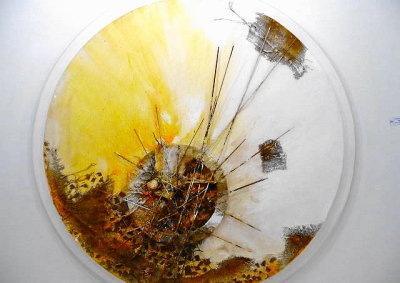 In the following you see three recent works. See also a his short comments (video).
In the following you see three recent works. See also a his short comments (video).
1. The caves.
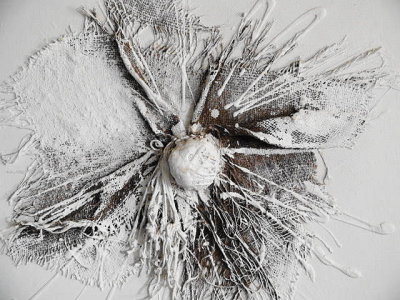 2. The blue of Samba
2. The blue of Samba
3. 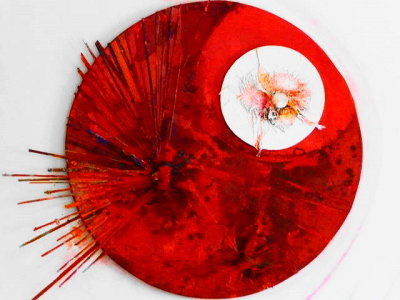 A blink on Seeva DIOP
A blink on Seeva DIOP
Sambalaye DIOP is a Lebou and member of the extended family of the great Marabout of the fishers, Seydina LIMAMOULAYE. He told us the extra-ordinary relationship between the great marabout and the sea. It is being said that at the birth of Seydina LIMAMOULAYE the fishers noted that the sea off the coast of Yoff was not salty.
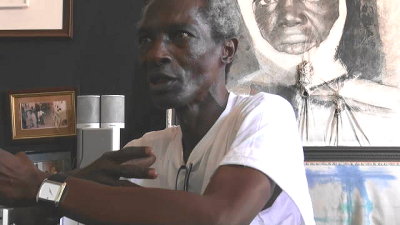 Hear and see how Sambalaye DIOP tells the story (video).
Hear and see how Sambalaye DIOP tells the story (video).
He also told us in a spirited manner about a freshwater well near the mausoleum of the great marabout, right next to the sea. This well is much used by the inhabitants of Yoff and the neighbourhood. Many of his works are in some way related to the sea and the marabout, who is claimed by the Lebou community as one of their spiritual leaders to this day.
Sambalaye DIOP tells the stories of his grandfather about the great marabout (video) of the Yoff fishers, Seydina LIMAMOULAYE. One symbolises the close relationship with the sea in a very special way - the marabout ordered the sea to retreat to leave space for the people to settle and it did.
The artist sees himself steeped in the Lebou culture and its special relationship with the sea, but also in the tradition of the great spiritual teacher and a sense of mercy, which pervades his art strongly.
He sees his implication in the Mare Nostrum Project as an extension of the work already started in collaboration with Aliou SALL with the secondary school (CEM) in Kayar.
The artists: Mamadou NDIAYE "THIA"
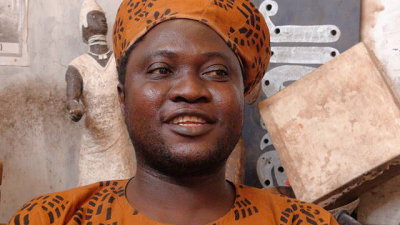 Aged 39 years, THIA THIA as his friends call him, is linked to the sea in two ways through his family. His father is a Lebou (the people of the sea who live on the Dakar peninsula) and his mother is from the Serere Niominka people who live in the islands of the Saloume.
Aged 39 years, THIA THIA as his friends call him, is linked to the sea in two ways through his family. His father is a Lebou (the people of the sea who live on the Dakar peninsula) and his mother is from the Serere Niominka people who live in the islands of the Saloume.
Mamadou settled in the historical centre of Dakar, the 'Plateau'. He used the geographical and morphological term 'Plateau' to inspire the name of his art workshop 'TEAUPL'ART'. See his self-presentation here (video).
You sense the man of the sea when looking at his works. On practically all his paintings we have seen, we discovered a man who takes inspiration from and expresses himself around themes connected to the sea, cultural values and specifically those of Lebou culture.
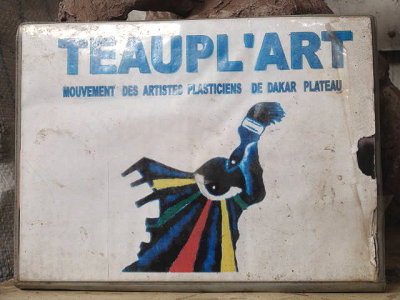 The themes derived from Lebou tradition are the famous dance "ndeup", the priestess, the link between certain Lebou songs and those of other African people of the sea, the origin of traditional wrestling and its relation to the sea, all these inspire Mamadou NDIAYE "THIA" profoundly in his artistic expression.
The themes derived from Lebou tradition are the famous dance "ndeup", the priestess, the link between certain Lebou songs and those of other African people of the sea, the origin of traditional wrestling and its relation to the sea, all these inspire Mamadou NDIAYE "THIA" profoundly in his artistic expression.
In his workshop, he reveals his art expressions with TEAUPL’ART, FESMIR and TEAUPLASSIKO.
TEAUPL’ART is the discovery of children with arts talents and who have not necessarily succeeded at school. The basic idea is to provide them with artistic skills, in artisanal activities and in music in order to make them fit at an early age to cope with jobs they can already exercise.
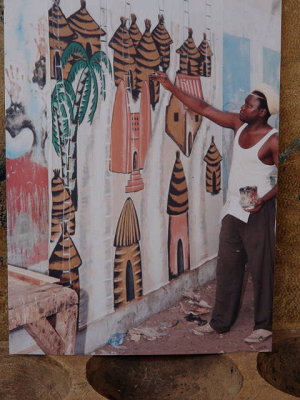 The apprenticeship is focused on plastic arts, sculpture and glass paintings.
The apprenticeship is focused on plastic arts, sculpture and glass paintings.
For artisanal skills, the focus is on batics, making bags and recycling material to produce art objects (e.g. lamp shades from calabasses).

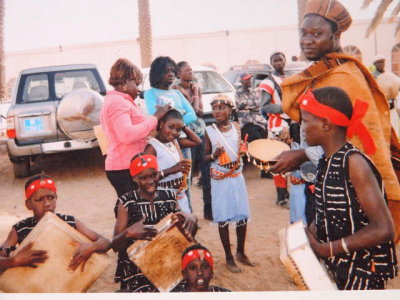 TEAUPLASSIKO is in turn the musical part of Mamadou NDIAYE THIA's activities.
TEAUPLASSIKO is in turn the musical part of Mamadou NDIAYE THIA's activities.
He always involves children (historical photo provided by THIA).
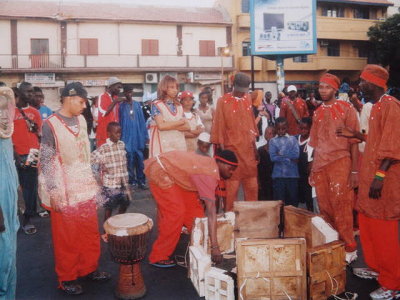 TEAUPLASSIKO is teaching children how to make music 'ASSIKO', which saw the day at the abolition of slavery, affirms Mamadou NDIAYE "THIA".
TEAUPLASSIKO is teaching children how to make music 'ASSIKO', which saw the day at the abolition of slavery, affirms Mamadou NDIAYE "THIA".
In Senegal as well as in Nigeria and Ghana the same term ASSIKO is being used, while in The Gambia and in Guinea, COUCOU is used instead (historical poto provided by THIA).
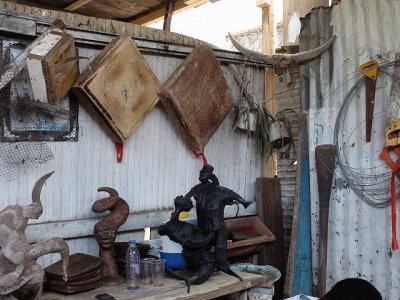 The instruments used in this type of music are for the most part recycled objects.
The instruments used in this type of music are for the most part recycled objects.
 FESMIR is a festival initiated by Mamadou NDIAYE "THIA" in the framework of his multiple activities. It is a space of diverse expression and an opening for all those taking advantage and participating.
FESMIR is a festival initiated by Mamadou NDIAYE "THIA" in the framework of his multiple activities. It is a space of diverse expression and an opening for all those taking advantage and participating.
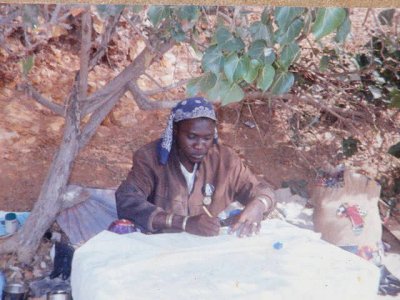 Mamadou's project with the children started on the beach.
Mamadou's project with the children started on the beach.
His dream was to set up a centre in ANSE BERNARD. But for lack of space he had to give up this location and set up the AIGLO workshops in town.
It is here that he regrouped his different activities in one company: AFRICA ART CULTURE (two historical photos provided by THIA).

 Mamadou can pull other registers too! He is also a man of the cinema and his exceptional relation with Moustapha NDOYE, the director of 'Combat for the sea', has been the most significant for him.
Mamadou can pull other registers too! He is also a man of the cinema and his exceptional relation with Moustapha NDOYE, the director of 'Combat for the sea', has been the most significant for him.
He ensured the film decoration of 'RIMBO POUR RAMBO' of film producer JEANTELE.
His all-round talent enabled him to be an anchoraman at TV5, director of 'TGV' by Moussa TOURE, decorator of a film turned in Mali and a comedian actor in "HYENES" of Djibril DIOP MAMEBETTY.
 During the meeting, Mamadou expressed strong appreciation for the Mundus maris Initiative and the Mare Nostrum - The voice of West Africa project.
During the meeting, Mamadou expressed strong appreciation for the Mundus maris Initiative and the Mare Nostrum - The voice of West Africa project.
The artists: Tamsir Diogou SECK
 Walking from the Socio-Cultural Centre to Tamsir Diogou SECK's workshop, Carla and Stefan took in the atmosphere of a part of Hann and some photos to share these impressions of the mix of robust structures and works in progress.
Walking from the Socio-Cultural Centre to Tamsir Diogou SECK's workshop, Carla and Stefan took in the atmosphere of a part of Hann and some photos to share these impressions of the mix of robust structures and works in progress.
Running water is not available in most individual households, though there is freshwater in the immediate proximity of the sea.
 Our route took us past a covered market with its different stands.
Our route took us past a covered market with its different stands.
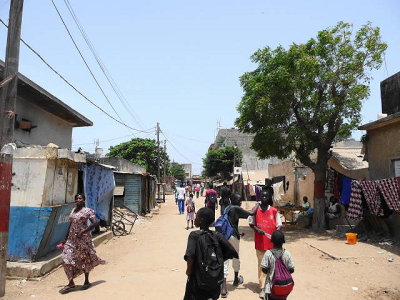 Houses are mostly built in stone and have electricity, but roads are not paved.
Houses are mostly built in stone and have electricity, but roads are not paved.
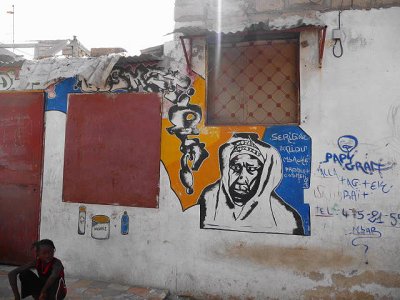 Images of spiritual leaders or other decorations adorn some houses.
Images of spiritual leaders or other decorations adorn some houses.
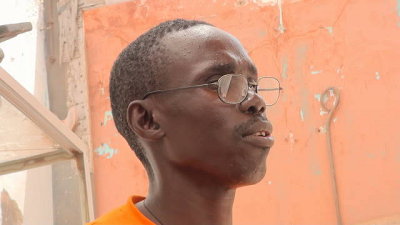 Like his friend THIA, Tamsir Diogou SECK has introduced us to his works.
Like his friend THIA, Tamsir Diogou SECK has introduced us to his works.
The two have collaborated in the past, as we discovered when visiting Tamsir in his quarters in Hann.
He explains his engagement to protect the Bay of Hann through his paintings, which centre on the rich themes drawn from cultural life and practices of the riparian population of the Bay.
 Have a look at his workshop.
Have a look at his workshop.
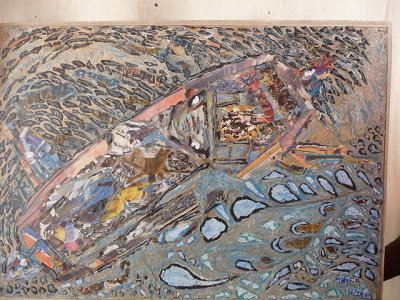 Another important theme for his art work is to approach clandestine emigration from different angles. In the following we show three paintings from this line of work.
Another important theme for his art work is to approach clandestine emigration from different angles. In the following we show three paintings from this line of work.
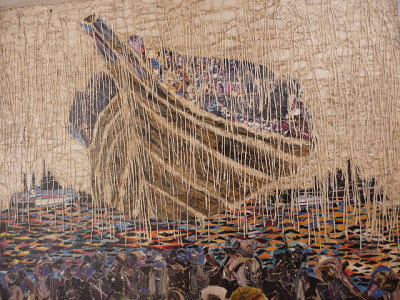 Since a long time, Tamsir Diogou SECK is engaged in this battle involving also the primary schools in the coastal villages.
Since a long time, Tamsir Diogou SECK is engaged in this battle involving also the primary schools in the coastal villages.
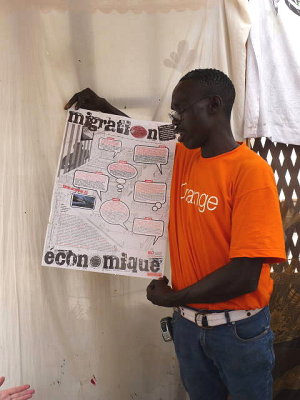 This is why Tamsir is very interested in the Mundus maris Initiative and more specifically its Mare Nostrum - A voice for West Africa project.
This is why Tamsir is very interested in the Mundus maris Initiative and more specifically its Mare Nostrum - A voice for West Africa project.
For this young artist, the project merits support from the people of the sea.
Tamsir offers his comments on the Mare Nostrum project. (video)
Hann - the natural park
 The well-known traditional fishing village of Hann is only some 7 km away from Dakar. The administrative district was constituted in 1996, ideally situated in a bay with three kilometers of beach, which also contains a nature park. The park has since been rehabilitated and now contains a lake and other anemities. The inhabitants are actively involved in its preservation.
The well-known traditional fishing village of Hann is only some 7 km away from Dakar. The administrative district was constituted in 1996, ideally situated in a bay with three kilometers of beach, which also contains a nature park. The park has since been rehabilitated and now contains a lake and other anemities. The inhabitants are actively involved in its preservation.
The park in Hann has its origins more than 100 years ago to meet several needs. The most important was the provision of freshwater for Dakar and the island of Gorée. The closeness of Hann to Dakar and its marshy character led to the drilling of wells starting in 1900.
Its official name is Parc Forestier et Zoologique. It still covers six hectares out of the original 73 hectares set aside. A short history of the park (French) can be seen here.
 Ibrahima, Carla and Tamsir seeking shadow in one of the pavillons.
Ibrahima, Carla and Tamsir seeking shadow in one of the pavillons.
 The park contains a colony of nesting pelicans.
The park contains a colony of nesting pelicans.
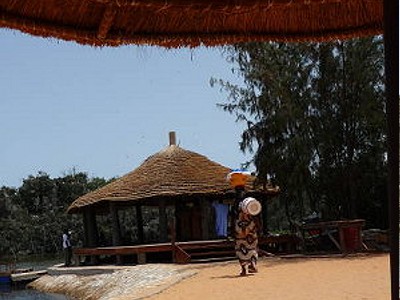
View of a pavillon with the typical reed roof.
Hann - The Socio-Cultural Centre
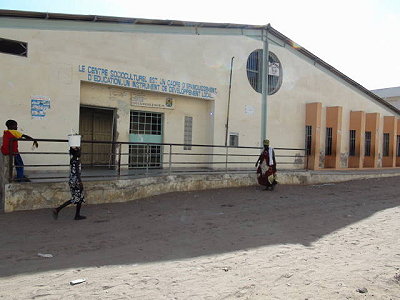
 Ibrahima SECK is the manager of the Centre and also responsible for the informatics training. Ibrahima works with the National Agency for the education of young people and makes sure that the ten computers of the cyber centre part are always in good order. See his short self-presentation (video).
Ibrahima SECK is the manager of the Centre and also responsible for the informatics training. Ibrahima works with the National Agency for the education of young people and makes sure that the ten computers of the cyber centre part are always in good order. See his short self-presentation (video).
Among its manyfold activities, the Socio-cultural Centre Hann offers introductions to an intelligent use of the internet. This training is much in demand by young people, but many women also take the introductory course in order to stay in touch with latest developments. See for yourself Ibrahima's video with explanations about the offers at the centre.
The spacious hall for theatre presentations (video) and other cultural events (to the right) is just one of the many facilities offered by the Centre. It is one of the social meeting points of the village of Hann, which is now part of greater Dakar.
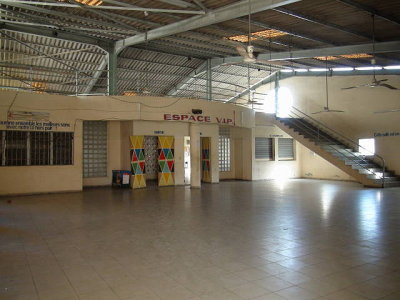
Growing vegetables is a lucrative activity close to a major centre of consumption, so it is not surprising that between 600 ang 800 women have participated in the training and stay in touch with latest developments thanks to the Centre.
This is a collaborative activity with the City of Milan in northern Italy.
Milan is planning the forthcoming EXPO 2015 as an alternative to conventional world exhibitions by putting different expressions of sustainable living right at the heart of the EXPO concept. The partnership with Hann might be an experimental field of new types of relations based on sustainability principles.
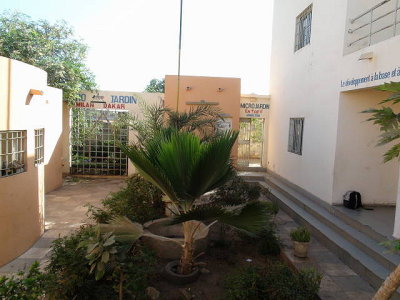 The photo shows the entrance to the micro-garden project training area.
The photo shows the entrance to the micro-garden project training area.
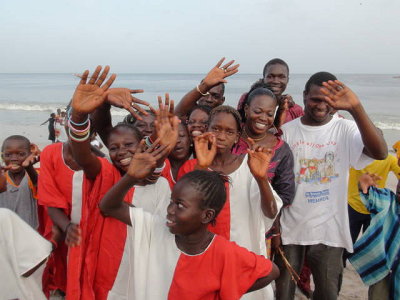 Among the cultural activities happening in the Centre is Mamy's dance group.
Among the cultural activities happening in the Centre is Mamy's dance group.
 It mobilises youngsters to practice the Lebou dance choreography accompanied by the traditional drums.
It mobilises youngsters to practice the Lebou dance choreography accompanied by the traditional drums.
 Click here to see it for yourselves live (video).
Click here to see it for yourselves live (video).
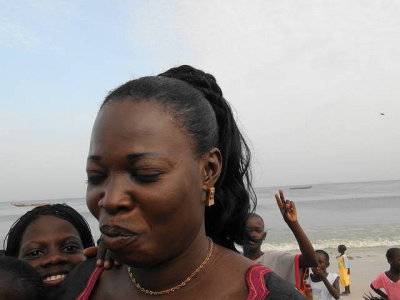 Mamy's dance group is also practicing on the beach.
Mamy's dance group is also practicing on the beach.
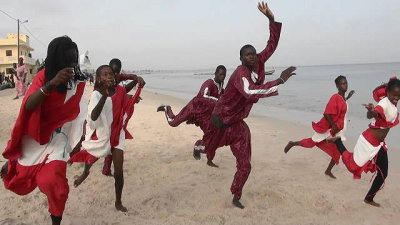 Here are two sequences, actively followed by onlookers, young and old, who find the drum rythms going to their feet and the sound of the waves in the background.
Here are two sequences, actively followed by onlookers, young and old, who find the drum rythms going to their feet and the sound of the waves in the background.
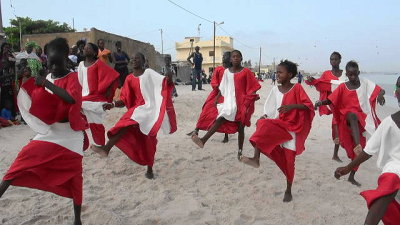 Video 1 with Lebou choreography.
Video 1 with Lebou choreography.
Video 2 with Lebou choreography.
Hann - CEM (Secondary School)
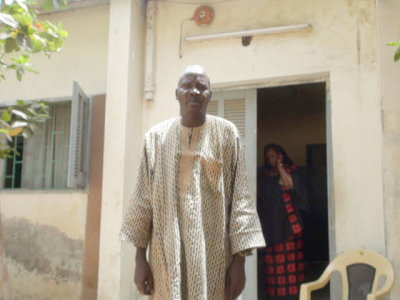 The well-known traditional fishing village of Hann is only some 7 km away from the centre of Dakar. The principal of the secondary school (CEM - Collège d'enseignement moyen) is Mr. DIOP.
The well-known traditional fishing village of Hann is only some 7 km away from the centre of Dakar. The principal of the secondary school (CEM - Collège d'enseignement moyen) is Mr. DIOP.
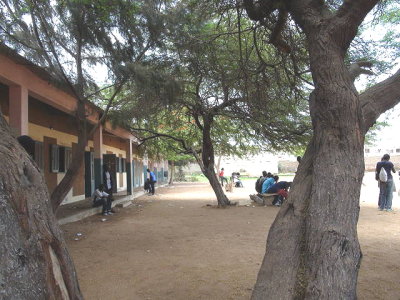 The visit at the school is a continuation of work already started by Ibrahima SECK together with the principal and the pupils. They have set up a working group similar to the one at the CEM in Kayar.
The visit at the school is a continuation of work already started by Ibrahima SECK together with the principal and the pupils. They have set up a working group similar to the one at the CEM in Kayar.
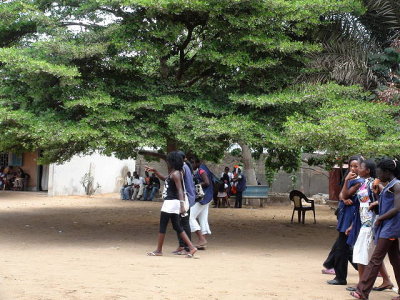 The Principal of the CEM in Hann, Mr. DIOUF, received us very openly allowing us to look around the establishment.
The Principal of the CEM in Hann, Mr. DIOUF, received us very openly allowing us to look around the establishment.
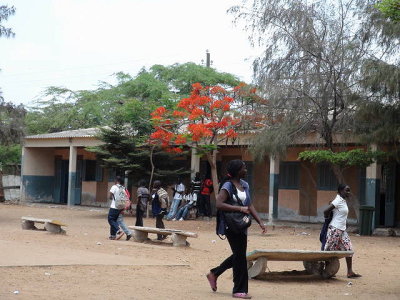 The clean buildings shaded under the trees make an attractive setting.
The clean buildings shaded under the trees make an attractive setting.
See also a short picture sequence on the setting of the CEM in Hann (video).
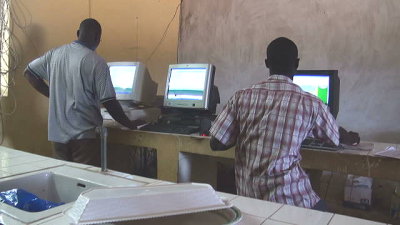 Mr DIOUF also showed us the IT room of his school, which currently has three computers.
Mr DIOUF also showed us the IT room of his school, which currently has three computers.
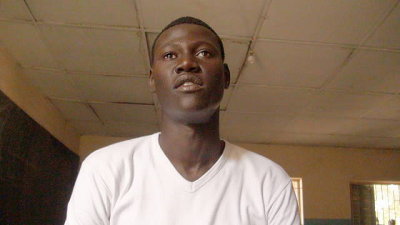 Following the guided visit around the school, we met with the President of the pupil representation (foyer socioéducatif), Mortalla LOUME.
Following the guided visit around the school, we met with the President of the pupil representation (foyer socioéducatif), Mortalla LOUME.
We had a very interesting conversation about the situation of the pupils and the working group set up with the help of Ibrahima.
Mortalla enthusiastically confirmed the commitment of the CEM Hann and his fellow pupils to participate in the project.
Hann - The fisher women
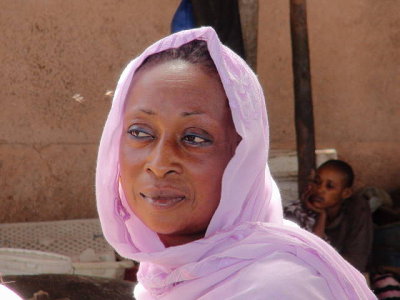 Right at the beach in the Bay of Hann, next to the pier, the dynamic fisher women dominate the postharvest activities within the fisheries sector.
Right at the beach in the Bay of Hann, next to the pier, the dynamic fisher women dominate the postharvest activities within the fisheries sector.
They practice some division of labour and one distinguishes, among others, fish processors, women taking off the scales of the fish and those removing the guts and cleaning the fish ready for consumption as fresh fish or freezing. The most important activity is, of course, the marketing.
The extended family of Yacine NDAW is among those involved in the fishery, processing and marketing. This is what she has to say (in Wolof) (video).
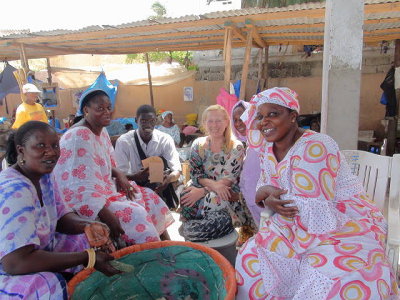 We have met Yacine NDAW, called DIAL, in a family-type setting, where she introduced us to her collaborators. It is women like them ensuring the principal part of the marketing of the fish, which they acquire fresh from the pirogues, when they come to shore. The photo shows Yacine's group with Carla and Ibrahima Seck in the middle.
We have met Yacine NDAW, called DIAL, in a family-type setting, where she introduced us to her collaborators. It is women like them ensuring the principal part of the marketing of the fish, which they acquire fresh from the pirogues, when they come to shore. The photo shows Yacine's group with Carla and Ibrahima Seck in the middle.
The women are known for their good organisation and the vendors work hand in hand with those taking off the scales and prepare the fresh product for the clients.
The a short sequence of pictures shows the surroundings (video).
 One of the fisher women proudly showing a big descaled catch for sale.
One of the fisher women proudly showing a big descaled catch for sale.
 A close-up of two of the women of Yacine's group.
A close-up of two of the women of Yacine's group.
The women also talked about the growing problem of getting enough fish to run their business - they are among the first to feel the results of overfishing.
They also have to cope all the time with changing demands of the market. This is particularly important given that fish is so perishable, particularly in the hot climate of Greater Dakar and that fish landed at the pier of Hann is mostly marketed fresh or frozen.
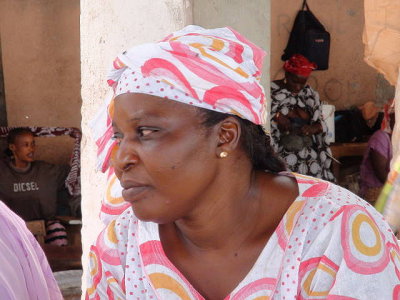 A close up of another group member active in the postharvest sector of the fishery.
A close up of another group member active in the postharvest sector of the fishery.
Click here to see the setting (video) of the landing and market place on board the sea in the Bay of Hann.
Hann - The landing pier and beach
 The Bay of Hann is one of the busiest artisanal landing places. This is no surprise given the proximity to a market like Dakar.
The Bay of Hann is one of the busiest artisanal landing places. This is no surprise given the proximity to a market like Dakar.
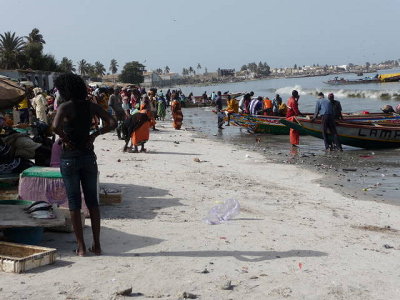 The arrival of the pirogues is always a colourful event.
The arrival of the pirogues is always a colourful event.
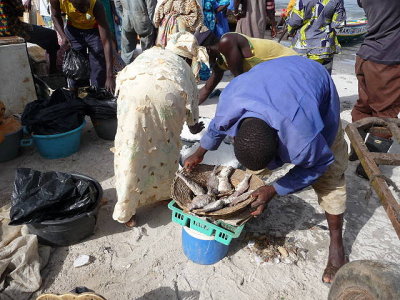 But it would be a mistake to put it away as simply pituresk or folklore - it's tough work and mostly successful business and a way of living nurtured by a strong culture of the people of the sea.
But it would be a mistake to put it away as simply pituresk or folklore - it's tough work and mostly successful business and a way of living nurtured by a strong culture of the people of the sea.
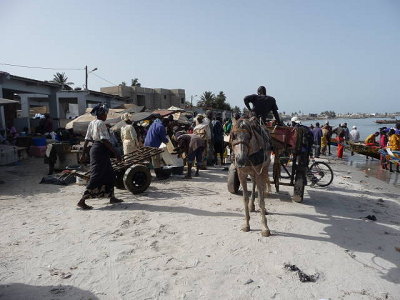 Part of the catch gets swiftly taken away to retailers in Dakar - by eco-transport on horse-drawn carts; though the means of transport is probably chosen more for economic rather than ecological consideration.
Part of the catch gets swiftly taken away to retailers in Dakar - by eco-transport on horse-drawn carts; though the means of transport is probably chosen more for economic rather than ecological consideration.
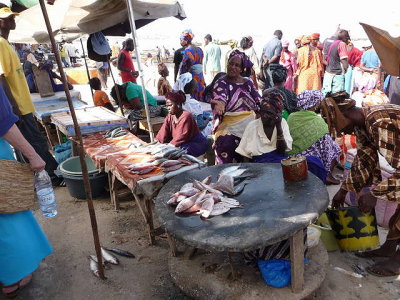 Another part of the freshly landed product gets immediately retailed next to the pier.
Another part of the freshly landed product gets immediately retailed next to the pier.
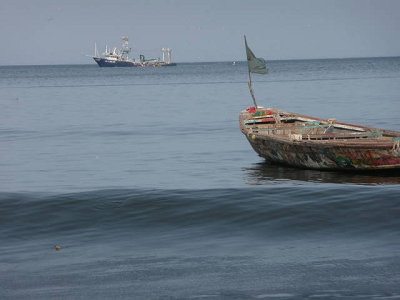
It would also be a mistake to frame the relationship between the artisanal and (often foreign) industrial fleets only as competitive and conflictual.
Here is a case of complementarity: the Japanese tuna hook and line vessel is waiting for the pirogues to deliver live bait fish.
When spotting a group of tuna, these small schooling fish will be released to get the tuna into a feeding frenzy. In this state, the tuna will concentrate within reach of the fishing vessel and can be caught more easily with hook and line. This way, the quality of the product is superb.
Yoff - The fishing village
 Yoff is among the oldest towns in this part of Africa and is first mentioned in 1432. Its distinct vibrant character is strongly influenced by its fishing traditions and the economy revolving around it.
Yoff is among the oldest towns in this part of Africa and is first mentioned in 1432. Its distinct vibrant character is strongly influenced by its fishing traditions and the economy revolving around it.
This town of about 50,000 has lost part of its communal lands in the 70s. The government later seized these lands and constructed Yoff International Airport on the lands.
Since 1996 it is renamed after Senegal's first president, Léopold Sédar Senghor.
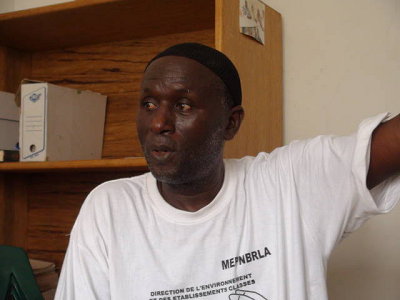
He sees the Mare Nostrum project as a way to give a voice to the fishermen. See the his message to the Mare Nostrum - the Voice of West Africa project (video).
Iba GAYE is a very experienced leader rooted in the long professional and cultural tradition of the place and its people, who have never stopped developing and innovating their community and finding new blends between traditions and modern perspectives. See another short sequence taken on the beach with him and Lamine DIABAN (video). Against the background of postharvest activities on the beach in Yoff, the two keep explaining their expectations about the future implementation phase (video) of the project.
With the help of Aliou, Carla met with several more people, including Ibrahima Diene, one of the fishermen. Ibrahima Diene, called Para by his friends, also serves in the municipal council. Hear what he has to say (video) on YouTube.
Yoff - Meeting the singer Ndir Mbengue
 Another one of the meetings was with a group of musicians who use instruments built from recycled waste materials. Daouda Mbengue is a singer and artist, better known as NDIR. Born in 1962 in Yoff, this Lebou artist is well-known for using recycled materials of everyday life as instruments, fuel containers, metal trays and spoons etc., very much in the tradition of African slaves, who were shipped to the Caribbean and the Americas from the Island of Gorée during the 16th to the 19th century. Through a mixture of Lebou rythm and a specific dance choreography like "ndawrabine" and the "goumbe", the group promotes the traditional Lebou music and plays regularly at the Socio-Cultural Centre of Yoff, in the occasion of the festival of the peoples of water in Yoff (Festival des peuples de l'eau) and also in Europe.
Another one of the meetings was with a group of musicians who use instruments built from recycled waste materials. Daouda Mbengue is a singer and artist, better known as NDIR. Born in 1962 in Yoff, this Lebou artist is well-known for using recycled materials of everyday life as instruments, fuel containers, metal trays and spoons etc., very much in the tradition of African slaves, who were shipped to the Caribbean and the Americas from the Island of Gorée during the 16th to the 19th century. Through a mixture of Lebou rythm and a specific dance choreography like "ndawrabine" and the "goumbe", the group promotes the traditional Lebou music and plays regularly at the Socio-Cultural Centre of Yoff, in the occasion of the festival of the peoples of water in Yoff (Festival des peuples de l'eau) and also in Europe.
In 1999 NDIR MBENGUE came out with his first album. Among others, he also produced a documentary film on the clandestine immigration entitled "Yonnu Guedje" in collaboration with the committee fighting clandestine immigration. Most unfortunately, our visit coincided with the passing away of a close family member, so that Ndir Mbengue limited himself to simply introducing the musicians of his group "Khandirane", Jazz, as well as explaining the origin of the materials transformed into instruments. His album is available on YOUTUBE. Click here to hear the music and see the dance choreography (video).
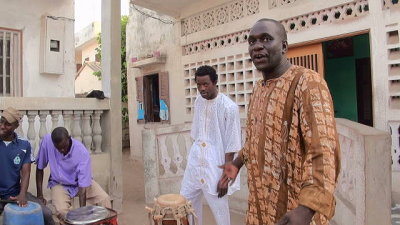 Ndir Mbengue presents Souleymane Seck (in white outfit) and Omar Seck (with violet shirt). Souleymane's instrument is a drum called 'thiole' with a body of recycled material. Omar plays on a large metal tray with spoons. The drum to the left used to be a plastic container for oil.
Ndir Mbengue presents Souleymane Seck (in white outfit) and Omar Seck (with violet shirt). Souleymane's instrument is a drum called 'thiole' with a body of recycled material. Omar plays on a large metal tray with spoons. The drum to the left used to be a plastic container for oil.
See the explanations live on YouTube (video).
 The next picture shows Souleymane Seck's instrument, the thiole, in a close up. In the background the metal tray of Omar Seck placed for better resonance on a big box.
The next picture shows Souleymane Seck's instrument, the thiole, in a close up. In the background the metal tray of Omar Seck placed for better resonance on a big box.
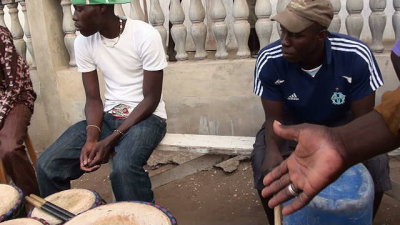 The photo to the right shows other members of the group - more drummers.
The photo to the right shows other members of the group - more drummers.
The different get togethers have been documented through photos and videos. The wealth of material will take some time to digest and will then be made available in greater detail.
Yoff - The Ndeup Ceremon
The "Ndeup" is a traditional Lebou ceremony. The Lebous consider this a practice to purify a person and the protect it from evil beings. This is anything but a folkloristic ceremony and rather responds to a need for protection. Every gesture has a meaning: the dances, the millet, the beat of the drums together with the litanies pronounced by the priestess. Very few persons and introduced into the secrets of this ceremony which get transmitted from generation to generation, each one safeguarding the secrets jealously. No pictures were to be taken, though snippets of the ceremony are included in NDIR MBENGUE's album video (see previous page).
Following Carla's meeting with the fishermen of Yoff, she participated in the Ndeup ceremony on three different days. In an undescribable atmosphere the drummers and dancers brighten up the inhabitants and onlookers before the priestess enters the fenced space surrounded by old ladies to do her prayers for the entire Lebou community.
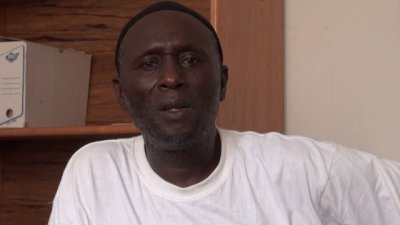 Ibrahima Diene, called Para by his friends, explains some aspects of Lebou dances and ceremonies (video).
Ibrahima Diene, called Para by his friends, explains some aspects of Lebou dances and ceremonies (video).
During the second day of Carla's presence, the inhabitants invited her active participation and practice the ritual greeting in the ceremonial space with the priestess as commonly done by the inhabitants themselves.
In the precious moments of the Ndeup ceremony, tradition does not allow certain acts. The priestess therefore received Carla in her private room where they could discuss Lebou traditions in general and this particular healing practice.
It is in this context that the priestess issued an invitation to Carla to join the great feast of the Lebou community next year. This feast takes place at the end of the wintering (dry) period and lasts 10 days.
Kayar - CEM (Secondary School - Collège d'enseignement moyen)
 Kayar is a traditional fishing town north of the capital Dakar. The Secondary School in Kayar (CEM - Collège d'Enseignement Secondaire) has already collaborated in the early days with our Initiative, first in a joint exhibition with works by pupils from the CEM Kayar and the European School Brussels I in Uccle in the occasion of the 50th anniversary of the European School (May 2008). The exhibition took place under the auspices of the then European Commissioner for Research, Dr. Janez Potočnik. Have a look here to see it.
Kayar is a traditional fishing town north of the capital Dakar. The Secondary School in Kayar (CEM - Collège d'Enseignement Secondaire) has already collaborated in the early days with our Initiative, first in a joint exhibition with works by pupils from the CEM Kayar and the European School Brussels I in Uccle in the occasion of the 50th anniversary of the European School (May 2008). The exhibition took place under the auspices of the then European Commissioner for Research, Dr. Janez Potočnik. Have a look here to see it.
The pupils have come a long way since thanks to the teaching of the artist Samba Laye Diop, who kindly took on some lessons and also enabled more learning through visits of particularly interested pupils in the Arts Village in Dakar. You can see the results looking at other productions they were involved with later - the image on the homepage of this website is indeed a group production of pupils of the CEM.
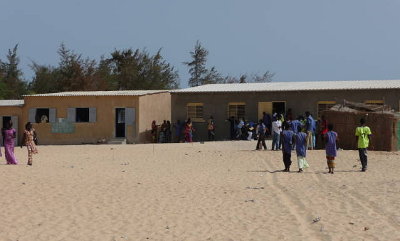
The principal of the CEM, Abibou Diop, was pleased to meet Carla together with one of the pupils ,who had benefited from the extra-art lessons, and explore new ways of collaboration with her and Mundus maris. Click here to see a short video capturing a moment of their meeting (video).
For the size of the fishing village, the school has modest facilities and size - not enough to accommodate all children. The College lacks running water and an internet connection to facilitate access to a wider array of information and networking with other schools in Europe and Africa is still on the 'to-do-list'
The principal summarised the history of Kayar, which is not only known for its traditional fisheries, but has also considerable agriculture potential. Having been founded only in 2006, the school is still very recent. It has six class rooms, a school canteen and a soccer field. Reafforestation is in the beginning and the next achievement will be the completion of toilets. He has 400 pupils.
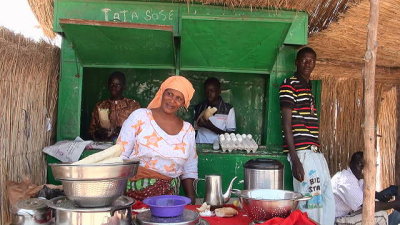
The canteen associated with the College is a hut on the beach with a straw-mat extension to provide some protection from the intensive sunshine.
To see the short video-sequence on YouTube about the canteen, click here.
Kayar - Centered on the fisheries
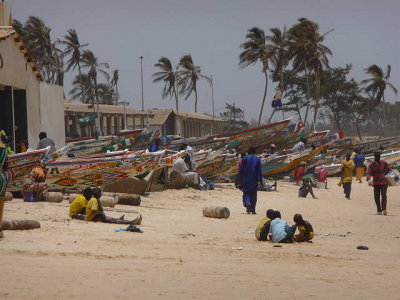 The heart beat of Kayar is the fishery. One next to the other, the pirogues are lined up on the beach, the pride of their owners and the fishermen braving the dangerous swell they have to get through when heading for the fishing grounds.
The heart beat of Kayar is the fishery. One next to the other, the pirogues are lined up on the beach, the pride of their owners and the fishermen braving the dangerous swell they have to get through when heading for the fishing grounds.
The major fishing season in Kayar lasts for six months (November to June). During that period, hundreds of pirogues converge on Kayar from other coastal regions in Senegal and neighbouring countries.
Until the 1980s the fishing was particularly lucrative and agriculture florished as well in Kayar. In the second half of the 1980s, around 1986/7, the effects of industrial fishing were becoming apparent. In this context, the fishermen felt obliged to adapt and introduce not only moderns, higher performance, gears, but also change the management methods.
Until then, the horizon of ambitions of young people was to enter the fisheries, not to go to school.

The next photo shows the view across some pirogues out onto the sea. The pirogues sit on trunks of palm trees to facilitate moving them about.
 It is hard work to pull a returning pirogue up to the safety of the beach. Trunks of palm trees serve as rollers to help get on with the job.
It is hard work to pull a returning pirogue up to the safety of the beach. Trunks of palm trees serve as rollers to help get on with the job.
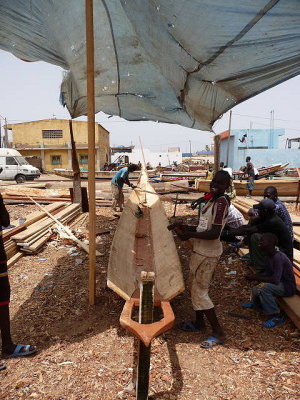 The beach is also the place for other types of action: here the carpenters are busy shaping a new pirogue. The master carpenter gets help from some young apprentices.
The beach is also the place for other types of action: here the carpenters are busy shaping a new pirogue. The master carpenter gets help from some young apprentices.
The skills get transferred from generation to generation, all without technical drawings!
Depending on the type of fishing they are intended for, the pirogues come in greatly different sizes.
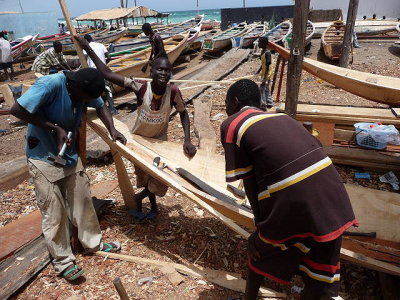 The rough conditions also require frequent repair work and wooden planks are now in short supply and expensive.
The rough conditions also require frequent repair work and wooden planks are now in short supply and expensive.
This notwithstanding, wooden pirogues are preferred over fibreglass boats.
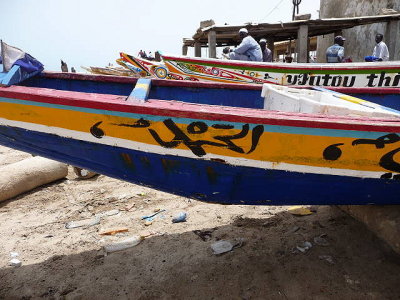 No pirogue will go to see without specific markings, sacrifices and all kinds of other ceremonies to put its work under a good star and make it bring back its crew and cargo safely from each trip.
No pirogue will go to see without specific markings, sacrifices and all kinds of other ceremonies to put its work under a good star and make it bring back its crew and cargo safely from each trip.
A first conclusion of my immersion in Senegal 4-19 June 2010
Frontiers open only if man ventures as far as the frontiers
"AFRICA - Whatever you thought, think again" - Jared Diamond
In 2005 this expression by Jared Diamond was the cover title of an issue of "National Geographic" - and it comes back in my mind now - one month after the return from my first immersion in Senegal.
I am still not really able to take a distance on all levels in the following first conclusion - too strong holds still the desire to get deeper inside of those unexpected essential experiences (not foreseen in my original agenda) that I focussed spontaneously on these synthetic versions in one of my diary pages while in Dakar (here a short extract):
… I came as a stranger
but since I have gone the first time
with the common transport
my vision has changed
I take part …
… Clandestine immigration …
… I have known black angels
come out of the sepulchral solitude
of an infinite, extraneous and hostile sea …
In my official report, published here on our website, you will not find any note that lets you imagine to which extent these days in Senegal had become a balancing act for me - regarding on the one side my Agenda and on the other the essential and sometimes existential experiences that can not be scheduled anywhere.
On these pages, I had to illustrate first of all in which way the 'Initiator' of the Project immersed in the living space of the region and the exemplary circumstances, in which she met the people, who could be involved in the realisation of the Project. Due to the shortness of time, she could not meet all those she would have liked to, but that should not impinge on their later participation, if they so wished.
Regarding this principal objective -
To prepare the Project 'Mare Nostrum - The Voice of West Africa' so that the Initiator, together with the regional coordinator, becomes able to give impulses in the float of life -
what does it mean to provide the methodological guide line enabling the involved people to express the essential roots of their living space in relationship to the sea - and finally to develop their own point of view.
On this level I can clearly answer that I came back not only enriched and with clear ideas how to set in motion the Project together with the Senegalese team, but I returned also with a strong vision about associated projects.
One of these associated projects has to do with my original idea (expressed in the original more comprehensive proposal in 2009) to make a film about the fisher woman in West Africa together with a young film director.
This idea returned with great power in my mind after having participated three times in the 'Ndeup' ceremony (with the many symbolic performances related to the sea - as for example the initial sacrifice and the final purification acts) and specially after the meeting with the Priestess in which she invited me to participate next year at the end of the winter time at the 10 day long ceremony in Yoff.
I imagine already that this participation could become the exemplary beginning of a film project about women in fishing communities in West Africa - because in my mind the Priestess is the key for the first deep approach to their nature, their social as well as cultural status.
I see already lively before me a film in two parts - I myself would feel responsible to find and to write the story - in collaboration with 2 female film directors: a European one and a West African respectively - two perspectives about women of the sea - an intercultural adventure.
One of the reasons for the chance to get a clear perception about some of the urgent problems of the Region, was not only the assimilation of the existential approaches of the visual African art scene - as I described it shortly in my report about the Biennale of Dakar - but also the great opportunity to see in the Off Events of the Biennale two films that touched the centre of my interest in the approach:
1) The Fight for the Sea
Documentary, France 2002, Moustapha Ndoye
More information: http://fr.wikipedia.org/wiki/Moustapha_Ndoye
This is the story of a meeting. Men and women from Senegal and Brittany (France), involved since years in the defence of traditional fishing.
2) Wax for wax, the words to say it
Documentary posthumous, Mustapha Ndoye, Senegal 2009
More information: http://fr.wikipedia.org/wiki/Moustapha_Ndoye
In Wolof, with French subtitles, Senegalese personalities, known and unknown, give their finishing words of illegal immigration.
This film gives also a clear vision about the desire of the Senegalese people: Africa should find the way to develop by itself.
Yes, I came home enriched and with a great affection for the Senegalese culture and the Senegalese people, with their human dimension, dignity and their great desire to overcome the pain of the past.
Still I know little about West Africa - and until now mostly on an intuitive level - but I anticipate already which promising outlook is encapsulated in the following words of Jared Diamond - a personality with a deep knowledge of Africa:
"Is the African continent doomed eternally to wars, poverty, and devastating diseases?
Absolutely not."
Bolsena, 19 July 2010
Carla Zickfeld
PS A short summary report bringing together insights from ecological and socio-economic research as well as the findings from the preparatory mission is available. It also contains a short bibliography of information sources for the reader interested in familiarising different dimensions with emphasis on West African fisheries, their ecosystems and the societies depending on the sea. Click here to download it.
Many Thanks to the friends in Senegal
(click on the picture so see its dynamic version with photogallery)
THE REALISATION - Collective Memory & Collective Consciousness
The first Cycle - Collective Memory
During the second immersion in West Africa - as soon as the budget will be secured – the Initiator, together with the local coordinator, would engage in 'introducing' the different themes of the first cycle "Collective Memory" in an exemplary way:
-
Where we are living - Our Sea as part of 'our world'
-
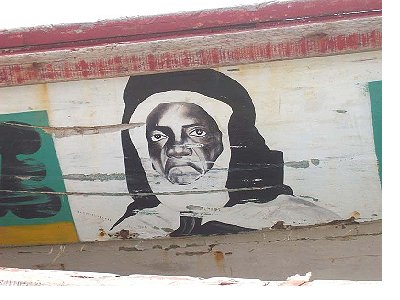 Symbolisms of our Sea
Symbolisms of our Sea
-
The songs about our Sea
-
The stories, the poetry of our Sea
-
The art and handicraft inspired by our Sea
-
The 'cuisine' inspired by our Sea
-
Our study of the Sea
Each group should have a still-to-be-defined number of panels in a still-to-be-defined format at its disposal and the means to realise a sound and a visual CD installation.
The equipment of the schools
All participating groups should be equipped in the same way and should have Internet access to develop their 'home' presentation within the web page of the Initiative.
The internet presence should be realized with programmes that allow easy handling.
From the first immersion in West Africa, the initiator will implement the project in an exemplary way. That involves preparing the young people for being able to visualize the approaches and to go then further autonomously - step by step.
Each visualized step should be communicated in a synthetic way on the web page.
Second Cycle - Collective Consciousness
The principles would be the same as in the first cycle - but until its start the various scientific modules about the modules about the fisheries and coastal resources in the region should be available on the web page. Several publications about the resource situation are already available, some of which are written for a general public.
THE MEDIATION - The conclusive Manifestations
The first cycle "Collective Memory" should conclude with a manifestation in Dakar that connects the Voices of connects the Voices of West Africa with the outside world; e.g. with the "Haus der Kulturen" (House of Cultures) in Berlin, Germany, the Goethe Institute in Rome or Brussels, the "MOA" - Museum of Anthropology ("New Arts - Across Cultures") in Vancouver, B.C. Canada.
Together with local artisans, we construct an African tent to host the different voices – and together with the involved young people, artists (visual, sound, literature), scientists, fishermen and women - we connect the voices that have manifested themselves to the outside world.
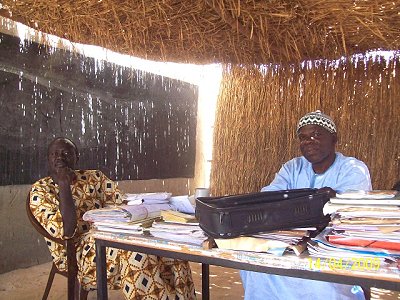 The Motivation for the idea to construct an African tent to host the different voices of West Africa
The Motivation for the idea to construct an African tent to host the different voices of West Africa
Says Carla Zickfeld: "When I met Aliou Sall the first time at Amsterdam in July 2009 in occasion of the first face-to-face meeting of the Mundus maris Initiative, he showed me the photo of the school director's office in Kayar. At this very moment I imagined already that it would be important in the future to mediate the authentic realities when we go on together on the road of intercultural exchange."
This manifestation will provide the experience to think about the manner and the place of the manifestation that should conclude the second cycle "Collective Consciousness".
THE PERSPECTIVE - the Network of Solidarity
After the first steps, the initiator could already start to activate potential partners - embedded in the 'Network of Solidarity' Intercultural exchange - for future connection of Mare Nostrum / Senegal with the First Nations of the Pacific Coast of British Columbia, Canada:
-
This manifestation will provide the experience to think about the manner and the place of the manifestation that should conclude the second cycle "Collective Consciousness".
- by connecting the final Manifestation in Dakar of Mare Nostrum with a new section of the Anthropological Museum in Vancouver "New Art Across Cultures".
- by an artist-exchange with those artists in coastal West Africa and coastal British Columbia who are interested in our wide objectives.
- by involving people of important scientific research Institutions and environmental NGOs of high public and professional standing to collaborate on the following arguments:
- Climate change - How humanity can adapt
- Relevant scientific knowledge on climate change - the mediation in the school network
- Developing the consciousness of environmental coastal risks.
-
Collaboration with academics, universities, specialised institutes operating at international level and interested and competent in the concepts of mediation, for example multimedia publication.
-
After the first cycle of Mare Nostrum, collaboration with universities, notably faculties of art pedagogy should reflect principally about the aesthetic formation proposed and experienced in the project Mare Nostrum: including what it means to integrate the aesthetic formation module 'Mare Nostrum' in their curriculum.









